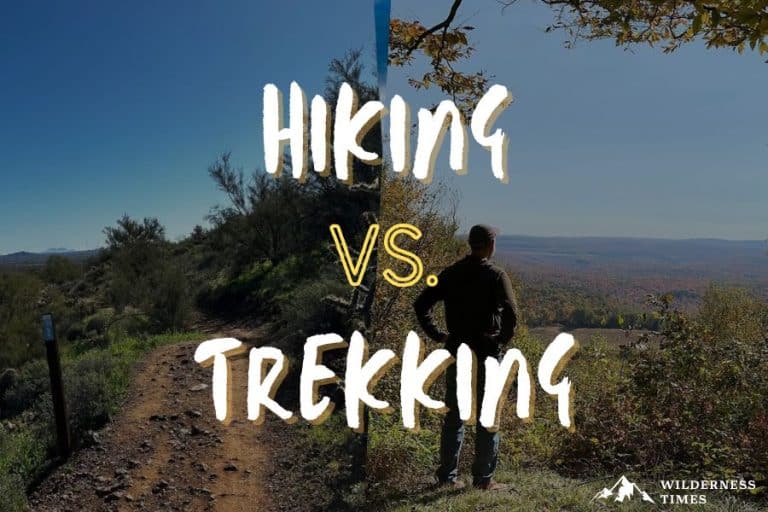Picture this: You’re walking on the trail on a gorgeous day. You might ask yourself, “Am I hiking or trekking?”
And it’s a fair question! Seemingly similar, these commonly used terms can easily get confused.
In this article, we’ll take a look at the meanings of hiking and trekking, so you can know which “-ing” you’re doing out on the trail.
Hiking vs Trekking
Hiking can be defined as a form of outdoor recreation that involves walking on trails or in natural areas, such as forests, mountains, or wildernesses.
Hiking is a commonly used term among the outdoor recreation community.
In fact, most online creators who dabble in outdoor recreation use the term hiking to describe their activity of walking in the woods for leisure or exercise routines.
Most hiking is done either alone, or “solo,” or with a friend, family member, or group of other hikers.
The definition of trekking as a “long, arduous journey” emphasizes time more than activity.
Someone who is trekking is hiking longer distances, usually spanning more than one day of adventure travel.
This definition refers to longer and more strenuous hiking trips, where physical fitness, training, and hiking skills have to be top-notch.
For example, a hiker who is thru-hiking a longer trail could also use the word “trekking” to describe their journey.
A simple walk around a loop trail is a great example of hiking, while a multi-day hike through a wilderness area is a great example of trekking.
Hiking vs Trekking: Differences
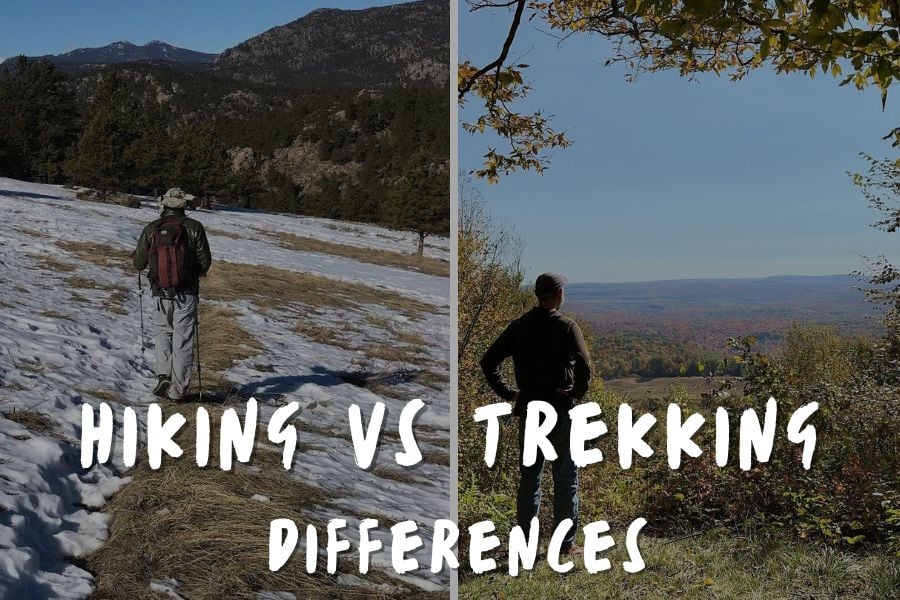
Let’s take a look at the differences between trekking vs hiking.
The main differences between hiking and trekking are the length of the trail, the duration spent outdoors, and the difficulty of your journey.
Hiking generally takes place on shorter trails during the daytime hours.
When I go for day hikes on the weekends, they might last four to six hours, depending on our speed and the sights on the trail.
However, if I were to set up camp on the trail for the night and continue down the path the following day, that definition would shift from hiking to trekking.
The time spent on the trail usually differs as well. Hiking as an activity usually ends on the same day the hike started.
Hikers usually hike somewhere to see something specific or get exercise but generally don’t stay overnight on the trail.
On the other hand, Trekkers typically plan for multi-day hikes, longer walking hours, and more intense exercise regimens.
The terrain and difficulty of hiking and trekking often differ as well. On hikes, the terrain is usually easier, and completing your trail isn’t as strenuous.
And, even if the hike is a little harder, it can usually be completed during daylight hours.
With trekking, you can expect the trail conditions to be more difficult, with rolling hills, roots, uneven trails, and other tougher obstacles in your path…
Logistics and navigation can also be easier for hiking than for trekking. Most hiking trails are marked and easy to follow, either on a map or on a hiking app, like All Trails.
In addition, many hiking trails are intuitive out-and-back or loop paths, making them easier to navigate without getting lost.
Trekking, on the other hand, is commonly done on moderate to rugged trails.
Many trekking trails may be poorly marked, and include old roadways, access trails, or longer trails often used for thru-hiking.
Hiking vs Trekking: Similarities
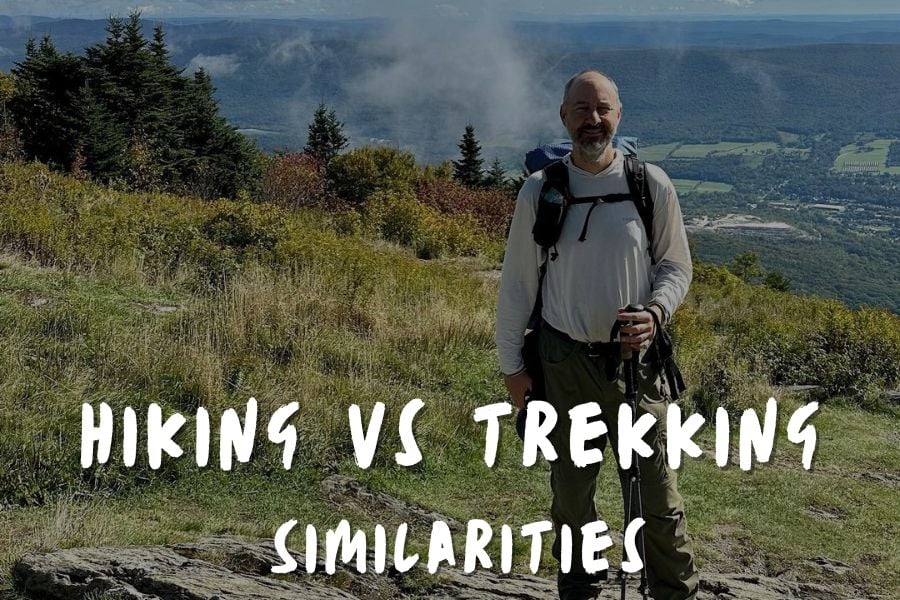
There are definitely similarities between hiking and trekking to take note of. Both activities are physical activities that allow you to connect with nature, go on adventures, and explore new areas – all while gaining immeasurable health benefits.
Both hiking and trekking are physical activities.
You can use both hiking and trekking as exercise routines that can help you get stronger and achieve your fitness goals.
However, because these activities are inherently physical, it’s important that you gradually work yourself up from shorter to longer hikes – and prevent any injury that may come from over-enthusiastic hiking or trekking activities!
Both hiking vs trekking allow you to connect with nature.
At their core, hiking and trekking get you out into nature and give you the opportunity to decompress away from your daily stressors.
Take the opportunity to breathe deeply – and maybe even learn more about native plants and birds!
Whether you’re taking a short hike or a longer trek, connecting with nature in this way can be great for your physical and mental health.
Both activities promote outdoor experience and adventure.
Going out on a hiking trail is an easy way to get an awesome outdoor experience. You can usually find trails of all different sizes and difficulty levels at state and national parks.
I commonly go hiking to explore new areas and go on historical adventures.
If I choose a shorter trail to hike, I’ll usually walk it to see the local plants and animals, including wildflowers, snakes, and other wildlife.
When I go trekking, I get to explore even more – and have even found old homesites and lightly trafficked views most people never get to see.
Trekking allows you to get off the beaten path and find even cooler views in the wilderness.
Both trekking and hiking have significant health benefits.
Hiking and trekking can be great activities to include in your fitness routine because they can be as strenuous (or not) as you want them to be.
This lets you be in charge of your fitness journey, and can lead to you becoming stronger and achieving wellness goals.
In addition to physical health, hiking and trekking have also been proven to improve mental health and help individuals cope with depression.
Getting away from the daily grind and into nature is good medicine for all of us.
Hiking vs Trekking: What should you choose as a beginner?
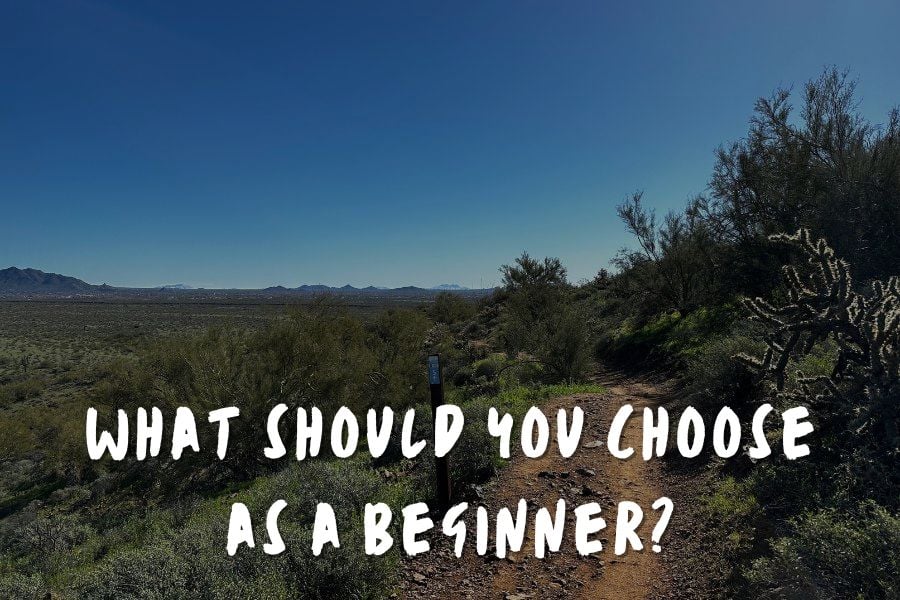
I always recommend beginners try day hikes to test the waters before they jump into the “deep end” of a trek. Why? Well, hiking is easier and will help you develop your competence and confidence in the outdoors..
And, because hiking and trekking can be taxing on your body and muscles, it’s better to start small and build yourself up to longer hikes – and eventually, epic treks!
For a step-by-step, it’s best to start out with easier hiking trails, move onto moderate hikes, and gradually get into the trekking world.. This way, you won’t injure yourself by going too far, too fast.
Day Hiking vs Multi-Day Trekking: A Comparison
There are comparisons between day hiking and multi-day hiking to consider.
Day hiking and multi-day hiking are both a form of hiking but have different functions.
Day hikes tend to last a few hours, while multi-day hikes could last a few days, weeks, or even months, pending on how long the trails and planned trips are.
Both types of hiking require specific gear and equipment. But day hiking typically requires less gear than multi-day hiking.
You’ll need a camp kitchen with extra food and water when you hike for more than one day.
You need a backpacking tent and other sleeping supplies from a sleeping bag to a mattress pad and a backpacking pillow.
You typically don’t need the extra gear when you’re just going for a simple day hike.
Planning for a day hike takes less effort than planning for a multi-day hike.
You can usually check the weather, dress for it, and use your map or app to get through the day.
You must account for each day on a multi-day hike, and planning can become much more extensive.
And lastly, multi-day hiking requires more physical strength, fitness, and comfort levels than regular hiking.
Most anyone can go day hiking.
You choose a trail based on your difficulty level, and you can gradually increase it by choosing harder trails as you progress.
But with multi-day hiking, you’re putting more strain on your body and experiencing harder activities.
Hiking is easy and can be improved more efficiently, but multi-day hiking can be very adventurous.
Also See: Hiking Injuries (Common Hiking Injuries and How to Treat Them)
Hiking vs Trekking: The Gear You Need
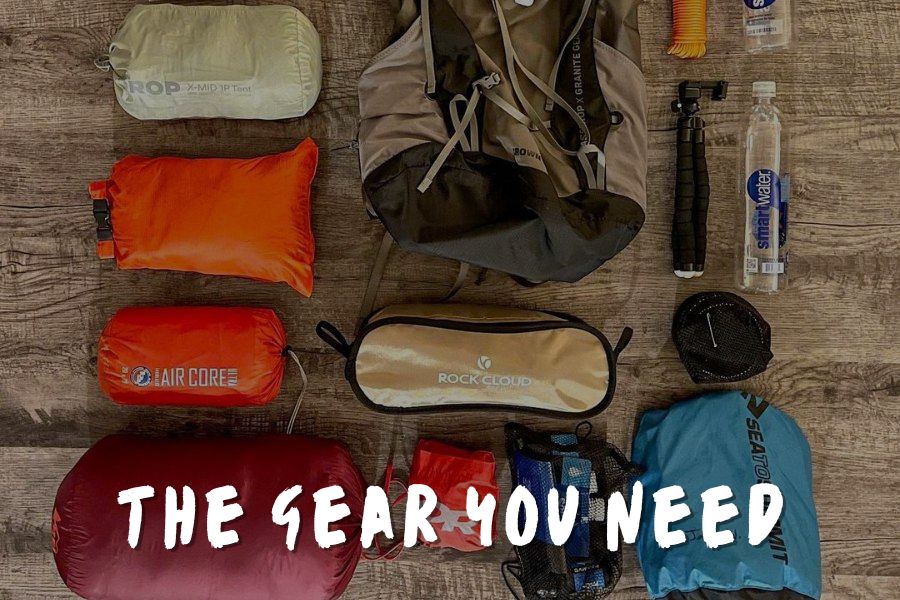
As we’ve covered earlier in the article, there’s a difference between hiking and trekking in the amount of time you’re spending on the trail.
Because of this, there is a difference between the type and amount of gear you need to take with you when you’re doing each activity.
When you’re hiking, you’ll just need gear for the day. This includes water, snacks, a first aid kit, a flashlight, and a bandana.
For clothing, all you’ll need is hiking boots, a rain jacket, and maybe trekking poles to help with the tougher sections of the trail.
However, for a trekking or multi-day hiking trip, you’ll need all of the above and more to keep you geared up and prepared.
Because of this, expect to have a bigger backpack that can hold more gear, including your food, water, tent, sleeping bag and more.
Depending on how long you’re trekking for, you may also need to bring kitchen items, including water filtration, pots, and a portable stove.
Basically, the longer you plan to stay out in the wild, the more gear you may need to bring with you.
Hiking vs Trekking: Safety Tips
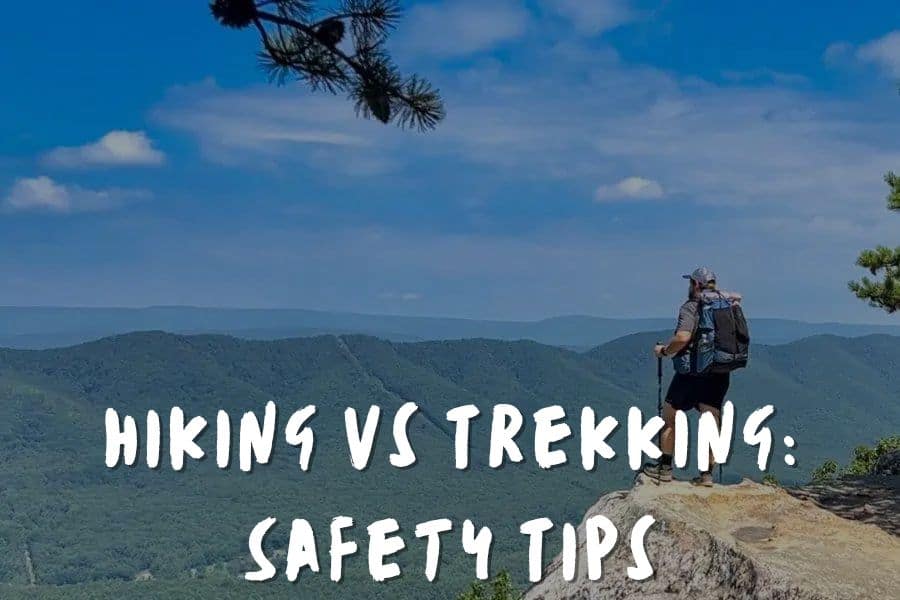
Let’s go over safety tips for hiking and trekking! Common sense can go a long way, but there are some specific tips that can help you get started.
First up, logistics. A safe outdoors person is one that plans.
Make sure you know which trail you’re going on and how long you’re going to be on the trail for. Then, plan your gear and pacing accordingly.
You should always tell someone what trail you’re going on, when you plan to return, and who you’re hiking or trekking with.
It’s also important to review your trail before you head out on your hiking or trekking adventure.
Make sure you have a map (or picture of a map) and feel comfortable navigating to your destination.
Trekking usually requires more advanced land navigation skills, like reading a topography (topo) map or using a compass.
However, if you want to level up your hiking competencies, bring a topo map or compass on your day hiking trips to practice your skills!
Like I mentioned in the section above, a longer hike may require more gear, so be sure to bring what you need for the duration of your trip.
For both hiking and trekking, always bring a first aid kit and a way to contact the “real world” (e.i., locator beacon or whistle) in case of an emergency.
Next, make sure you’re aware of the potential environmental and wildlife-related risks prevalent in the area, especially considering any wildlife that may share the area with you.
For example, when you are trekking in wilderness areas, you might encounter bigger predator animals, such as bears, mountain lions, and wolves.
Activity levels for these animals can vary depending on the time of day and season of the year, so do your research and take preventative measures (e.i., pack bear spray, and make regular loud noises) to stay safe.
Remember that this is their home, and you’re just visiting!
Finally, stay hydrated and fueled – and know your limits! Be sure to drink plenty of water and eat plenty of carb-loaded foods and snacks to keep yourself fueled on the trail.
And, make sure you pace yourself and understand what physical activities you can and can’t do so you can keep yourself and others safe.
Follow these tips and, most importantly, use your common sense, to keep yourself safe while hiking and trekking.
FAQs
Read on to learn more about some of the common frequently asked questions concerning hiking and trekking.
What is the biggest difference between hiking and trekking?
The biggest differences between hiking and trekking are the difficulty of the trail and the time spent on the trail itself.
Hiking is usually easier and done within one day during the daylight hours.
Trekking is usually done on more difficult terrain and typically lasts more than one day.
Is hiking shorter than trekking?
Usually, yes. Hiking is typically done on loop or out-and-back trails that only take a few l hours to complete.
Trekking, on the other hand, is typically done on longer trails that require multiple days, weeks, or even months to complete.
Some people will even trek worldwide, which can take them multiple years.
What types of terrain are typically encountered while hiking vs trekking?
When hiking, most people encounter easier to moderate terrains with some roots, rolling hills, or uneven surfaces. However, most of the time, hiking trails are fairly easy to follow.
Trekking trail conditions typically range from moderate to very rugged. Most trekkers can expect significant elevation gains, mountainous regions, and rough trails that can be more difficult to follow.
What distance is considered a hike?
In most cases, a day hike’s distance will range from less than a mile to one to eight miles.
This range is about as many miles as a person can hike in one day without worrying about not being back to their starting point before nightfall.
This gives hikers plenty of time to stop and look at sites along the trail, take photos, and enjoy the natural surroundings they encounter.
What distance is considered trekking?
Trekking is typically longer than hiking.
You can usually expect trekkers to hike ten to twenty miles a day or within a few days.
Many thru-hikers will try to cover as much ground as they can each day and will plan rest days to rest and recover.
Because trekkers are focused on covering more miles in a day, they tend to enjoy the natural sites on the way and travel faster with fewer stops.
Conclusion
While similar, hiking and trekking largely differ in the length and difficulty of your outdoor adventure.
However, both activities will get you into nature to have a great adventure in the outdoors!
Hiking and trekking saved my life and have made me healthier each time I do them.


